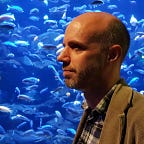Godzilla vs. Hedorah’ or — Kaiju Pop Art?
‘Godzilla vs. Hedorah’ (1971) is one of the more distinct entries in the big lizard’s franchise but the aspects that make it unique are also those that add to its very significant appeal.
For one thing, like the original, it explicitly tackles a real world issue that afflicted Japan — the diseases and terrible medical conditions caused by pollution and toxic metal poisoning. This, combined with the fact we see the direct effects of Hedorah’s damage on human beings as opposed to inert infrastructure and buildings gives the film a dark edge and real sense of horrifying threat.
Hedorah is a monster formed from the pollution, waste and effluence humans have pumped into the oceans over the years and as it slithers, flies and stomps across Japan spreading its noxious gases and gunge in its wake we see people suffocate, dissolve and submerged in its lethal sludge.
Also, rather than the plot revolving around Interpol, alien invaders or sinister organisations this time round it’s specifically focused on a single family and their attempts to halt the creature which means there’s tangible human stakes at play along with a more grounded tone. There’re some scenes here that are genuinely pretty grim and nasty.
Not that the film’s a bleak and heavy downer as the other aspect of ‘Godzilla vs. Hedorah’ is just how much New Wave influence, pop art, late 60’s/early 70’s cartoons, music and psychedelia director Yoshimitsu Banno injects into it all making this one of the most visually striking, inventive and varied of the series.
So lava lamp backgrounds in hip nightclubs give way to fast cutting blasts of colour followed by animated depictions of Hedorah gorging on industrial waste as though we’re watching a mash-up of early John Boorman with Gerald Scarfe’s sequences from Pink Floyd’s ‘The Wall’ (1982).
Then there’s the shot of Hedorah feasting on the fumes of a broiling smokestack and it’s an image so uncanny, eldritch and eerie it feels like a precursor to the freaky Guild Navigator from David Lynch’s ‘Dune’ (1984). It’s a truly remarkable moment, even more than the meowing cat covered in gunk which is freaky enough as it is.
Yet the film’s most out-there sequence is an astonishing montage revolving around the image of a crying baby buried up to its neck in a pit of dirt that fractures into a geometrical grid of pulsating, multicoloured squares that then hard-cuts to a tadpole being electrocuted in a blinding flash of light into a smouldering mineral compound. It’s insanely dynamic and overwhelming, as though Jean-Luc Godard had directed an episode of ‘The Monkees’ TV show.
All this flashy ostentation wouldn’t count for much if there wasn’t a strong narrative backbone to it all and the good news is ‘Godzilla vs. Hedorah’ contains one of the more straightforward and effective plots (although it’s still a Godzilla movie so it’s still pretty wild) that delivers its message with a surprising amount of punch. And best of all, it’s perfectly paced.
‘Godzilla vs. Hedorah’ is certainly one of the more unusual kaiju movies ever made but that wonderful uniqueness is definitely part of its charm, a charm that’s only magnified by some incredibly idiosyncratic and evocative visuals. The only downside is its message about how we’re fucking up the planet is more urgent, and worrying, now than ever, and we don’t have Godzilla to save us.
